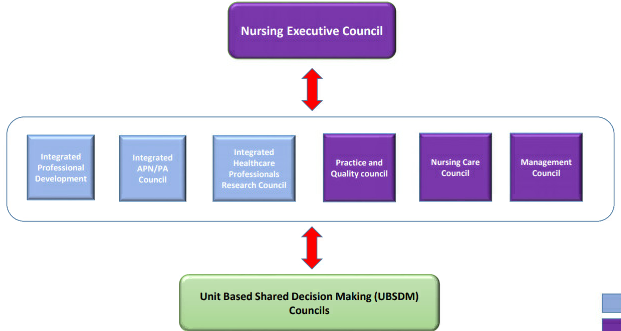
As a unit staff nurse, have you ever thought, “I wish they would’ve asked my opinion before making that change in practice?” Many times throughout my career I’ve thought just that, but I’d never been in a position where I could share my opinions. However, getting involved in a shared decision making (SDM) structure opened up new opportunities for me.
SDM is based on principles of partnership, accountability, equity, and ownership. It encourages diverse, creative input to advance an organization’s healthcare mission. SDM models are not just used in nursing but also disciplines like finance and academics. A strong SDM model at a healthcare organization can reassure nurses that their opinions do matter, include them in conversations, and ultimately lead to a sense of empowerment and increased job satisfaction.
Implementing the SDM Model
An ideal SDM model involves all levels of nursing—from senior nurse executives to the clinical staff nurses—allowing communication, decisions, and information to flow multidirectionally. It should also include a multiyear nursing strategic plan that aligns with the health system’s strategic plan. We’ve found the model at our institution highly effective (see Figure 1).
In the first level, we developed a nursing executive council that’s led by the chief nursing executive and consists of senior nurse leaders, nurse managers, and staff nurses, who serve as chairs for the hospital-wide councils found in level two.
Our second level includes six hospital-wide SDM councils. Each council develops a nursing tactical plan that directly links to the nursing strategic plan. The plans provide direction for each council’s work as well and serve as the tool to double-check progress towards their goals.
The hospital-wide councils consist of the following:
- Advanced practice providers
- Management
- Nursing care
- Professional development
- Quality and practice
- Research
Each council has a senior nurse leader who serves as the executive sponsor along with a professional practice team member who serves as the facilitator. Those individuals work directly with the chair and co-chair, who are front-line clinical nurses. As the chair of the quality and practice council, I’ve had the great experience to be mentored by those senior leaders. I’ve learned how to effectively prepare for and lead meetings, and I’ve increased my knowledge and skills in quality improvement activities. Ultimately, the councils report to the nursing executive council on a rotating basis throughout the year. This framework allows each team to receive feedback from the nursing executive council, while also keeping the executive team aware of the other groups’ activities.
The third level of our SDM model includes unit-based shared decision making (UBSDM) councils. Each unit sends one representative to each of the hospital-wide councils, allowing for bidirectional communication among all levels of the model. UBSDM councils have oversight of their unit-based tactical plans, which also align to the greater nursing strategic plan. The unit-based councils are chaired by staff nurses and facilitated by unit managers.
SDM Leads to Shared Success
After two years of executing the SDM model at our organization, nurses are feeling empowered knowing they have a voice in decisions that affect their practice. One of the biggest challenges with any SDM model is to make sure that staff nurses have the time to attend meetings and work on the resulting tasks after each meeting. We’ve found that by following the principles of SDM and having staff nurses work directly with their leaders, we developed innovative ways to overcome this challenge.
I would love to learn how your organization is using SDM models. Please email me your thoughts, questions, or any feedback you have to TheOncologyNurse@gmail.com.

The author would like to acknowledge Gina Reid Tinio, PhD, MS, MPH, RN-BC, and Sandi Hutchinson, MSN, RN, ACE, for their help in preparing this article.






